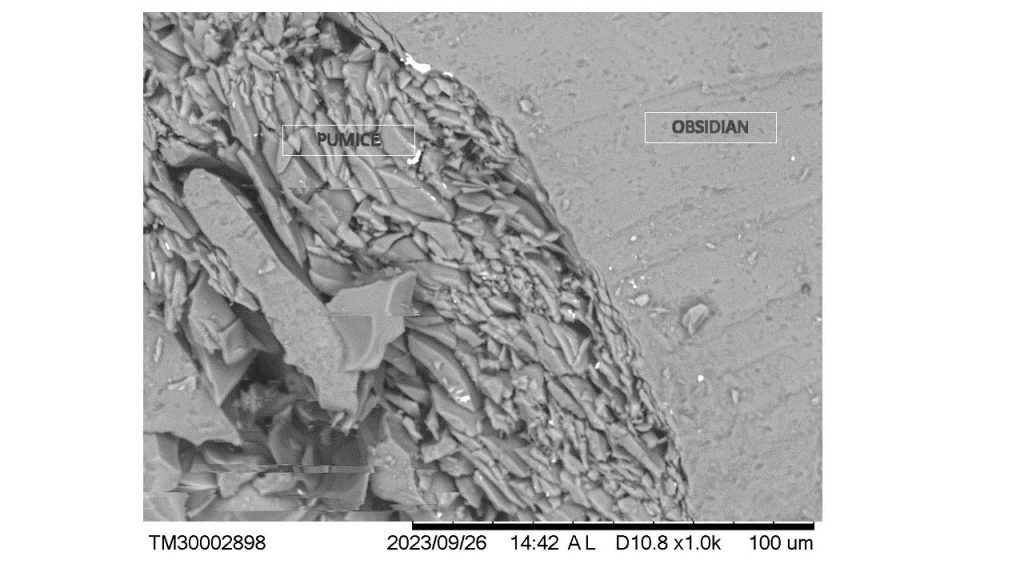05 – AN OBSIDIAN FROM SETE CIDADES LAGOON ON SÃO MIGUEL ISLAND, AZORES, PORTUGAL
Ano 10 (2023) – Número 3 - Obsidiana de Açores Artigos

10.31419/ISSN.2594-942X.v102023i3a5MLC
Marcondes Lima da Costa1
Susana Horta2
Pabllo Henrique Costa dos Santos1
Glayce Jholy Souza da Silva Valente1
Dario Carvalho Pinto2
1Geociences Institute (PPGG/Federal University of Pará), 66075-110, Belém, Pará, Brazil, marcondeslc@gmail.com
2 Av. António Medeiros Almeida 4H 2AB, Rosário, 9560 Lagoa Açores, Portugal
ABSTRACT
An obsidian sample collected in the pyroclastics of the Sete Cidades Volcano, on the island of São Miguel, in the Azores, Portugal, was analyzed mesoscopically, by XRD and SEM/EDS. Its widespread characteristics are compatible with materials found around the world. It is black in color and is magnetic. The sample presents irregular bands of pumice, which undermines the quality of obsidian as a lithic and even gemological artifact. The mineralogical and chemical composition conforms to obsidian formed from rhyolitic to quartz trachytic lavas. The relative higher levels of FeO and TiO2 are worth highlighting, which appear in the form of magnetite, titanomagnetite and even ilmenite, in micrometric to nanometric inclusions, which account for their black color and slight magnetism. Other micrometric to nanometric inclusions are possible alloys of Fe-Cr-Ni and Cu-Zn-Ni and even gold particles, which suggest a slight mafic influence during the acid to alkaline volcanism.
INTRODUTION
The island of São Miguel is the main island of the Azores archipelago, which is made up of 9 main islands, of which São Miguel is the largest in area and demographic occupation. They are volcanic islands, linked to the northern mid-Atlantic ridge. They result from the triple junction between the North American, Neurasian and Nubian lithospheric plates (Ellis et al. 2022).
On the island of São Miguel, five active volcanic systems are recognized: three central volcanoes with caldera (Sete Cidades, Fogo and Furnas) in the western portion of the island separated by two basaltic fissure systems (Picos and Congros) and two extinct volcanic systems (Povoação and Nordeste) that constitute the eastern part of the island (Gaspar et al., 2015a). In historical times the Fogo and Furnas volcanoes erupted explosively in 1563, and 1439/1443, and 1630, respectively, with smaller eruptions in the Picos fissure system in 1563 and 1652 (Gaspar et al., 2015b).
The volcanic stratigraphy of Sete Cidades, on the western end of the island, where we collected the sample for this study, comprises two groups: the Lower Group, older than 36 ka, composed of basaltic and trachytic lavas and few pyroclastic deposits (Ellis et al. 2022); the Upper Group, which includes all deposits aged less than 36 ka, comprises six formations: the Risco Formation (36 ka), Brittany (29 ka) and Santa Bárbara (16 ka), dominated by pyroclastic interspersed with the Ajuda and Lombras, made up of pyroclastic and basaltic lavas. The Lagoas Formation is the youngest in Sete Cidades, and comprises the Cascalho Negro Member (16–5 ka), with pumice deposits, lava domes and deposits associated with ash flow and blocks, lava flows basalt and scoria cones and the Pepom Member (< 5 ka) composed mainly of trachytic pumice deposits from the caldera (Ellis et al. 2022).
The Sete Cidades volcano is about 25 km from the capital of the Azores, Ponta Delgada (Fig. 1), and is the westernmost volcano on the island, with repeated eruptions during the Holocene (Ellis et al., 2022). The landscape inside and around it is simply stunning (Fig. 2). In its last eruptions it produced a series of Pepom with seventeen deposits of trachytic pumice through openings within the caldera. It is vesicular glass equivalent to pumice fragments and dense glass equivalent to obsidian. While eminently trachytic vesicular pumice glasses were investigated by Ellis et al (2022) in their detailed geochemical study of the Pepom tephra deposits, obsidians were not considered. The pumices are mainly formed by anorthoclase and sanidine-type feldspars, as well as clinopyroxenes with a magnesian tendency, with inclusions of apatite and Fe-Ti oxides, and biotite also with a Magnesian tendency. The Pepom tephra deposits demonstrate the maximum evolution of the most recently extravasated magmas in Sete Cidades (Ellis et al. 2022).
This work presents the mineralogical and chemical results obtained from a sample of obsidian fragment collected in a road embankment that cuts across the steep slope formed by pumice and obsidian deposits (Fig. 3), on the margin of the lagoon formed within the crater of the Sete Cidades volcano, on whose outskirts is the city of the same name.
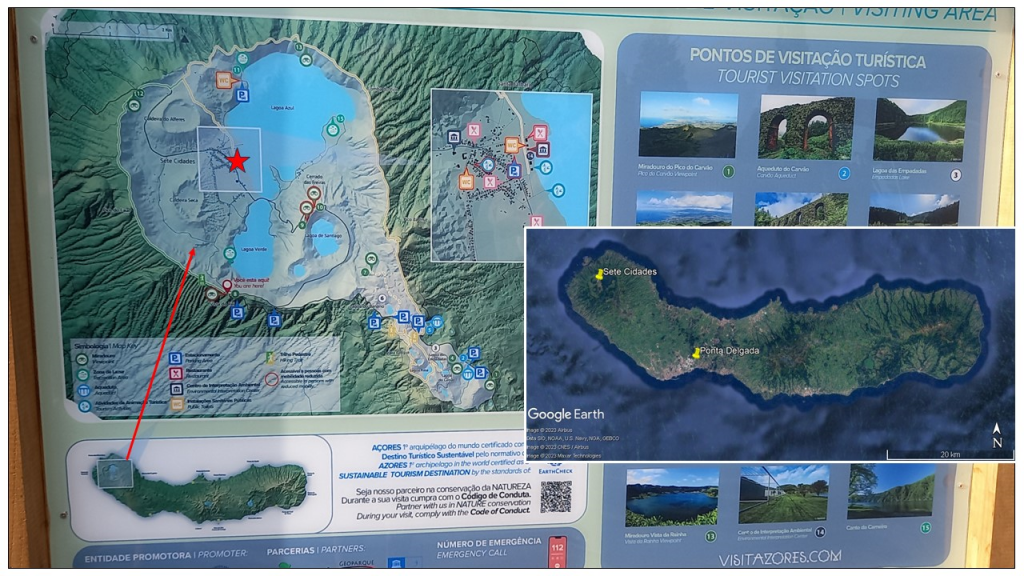
Figure 1 – Location of Sete Cidades on the island of São Miguel, in the Azores, and image of the tourist sign with various information about the environment and outlining the main and smaller craters, as well as the lagoons. The red star approximately indicates the collection point of the obsidian sample investigated in this work. The image of São Miguel Island in the center right is from Google Earth pro (accessed on 10/11/2023).
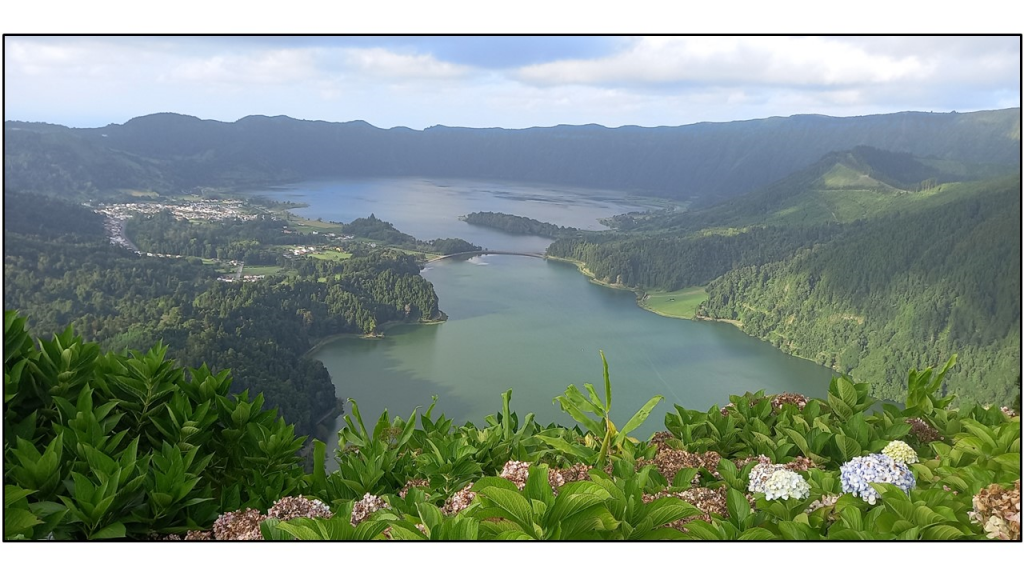
Figure 2 – General view of the beautiful landscape developed on the walls of the large crater of the Sete Cidades volcano, highlighting the steep walls covered by thriving green vegetation, the lagoon and the city of the same name. Image by MLC on 09/08/2023.

Figure 3 – Tephra deposit (pyroclastic) on the lake margin (A) and detail of the zoning of these deposits in accordance with energy and water level in the lake (B). Fragments of pumice (white color) and obsidian (dominant black color), with emphasis on the largest fragment in the center of the image, measuring approximately 10 cm in length (C). In detail (D) thin bands of pumice-like material (pumice stone) can be seen. The investigated sample took place in Sete Cidades, São Miguel Island, Azores, on 09/08/2023 and investigated in this work. MLC images on 09/08/2023.
MATERIAL AND METHODS
The largest sample, in addition to several smaller ones, was collected on a secondary road on the banks of the large Sete Cidades lagoon, which sections the foot of a large tephra slope, basically consisting of pumice and obsidian fragments in a matrix of fine material (silt to sand). ) whitish gray in color (volcanic ash) (Fig. 3). On the beach of the lagoon, mainly pumice fragments accumulate, which, due to their low density, are carried by the waves to the shore, where they partially accumulate (Fig. 3 A, B).
The sample in question was described mesoscopically, after which an aliquot was extracted for mineralogical identification by X-ray diffraction, powder method, and, therefore, previously pulverized in an agate mortar. This analysis was performed by a Bruker D2 Phaser X-ray diffractometer equipped with a Cu anode and a Ni-kβ filter, at the Federal University of Pará, Brazil. We used the powder method. The diffractometer was set in the θ-θ Bragg-Brentano geometry with a Linear Lynxeye detector. The sample was ground in an agate mortar and measured in reflection mode from 5° to 70° 2θ range with 0.02° step size and 38.4 s per step counting time. The mineral characterization was performed using the software HighScore Plus 5.0, with the aid of the database of the Powder Diffraction Files from the International Center for Diffraction Data (ICDD).
Another small aliquot was subtracted for spot chemical analysis by Scanning Electron Microscopy (SEM) with Energy Dispersive X-ray Spectrometry (EDS. To obtain images and semi-quantitative chemical analyses (spot and area mapping), Hitachi TM3000 Scanning Electron Microscope coupled to a Swift ED300 Energy Dispersive X-ray Fluorescence Spectrometer (EDS) was used, with voltage acceleration from 5 to 15 kV and with SDD detector (161 eV Cu-Kα) from the Institute of Geosciences of the Federal University of Pará. The analysis was performed under a low vacuum whether the sample is metallized or not.
RESULTS AND DISCUSSIONS
The sample is black in color, with a classic conchoidal fracture (Fig. 3 C, D), with a slight flow structure, in which whitish, partially vesicular, fibrous pumice-like portions stand out (Fig. 4). But overall, it is compact, and has a perfect glass appearance. The obsidian sample is slightly ferromagnetic.
The mineralogical analysis by XRD clearly shows the dominance of amorphous material (wavy back), therefore glass, but also highlights the presence of anorthoclase, mica (biotite, probably) and quartz (low temperature) (Fig.5). The mica was considered as biotite, as it is the micaceous mineral described by Ellis et al (2022) in the associated pumice fragments in Sete Cidades.
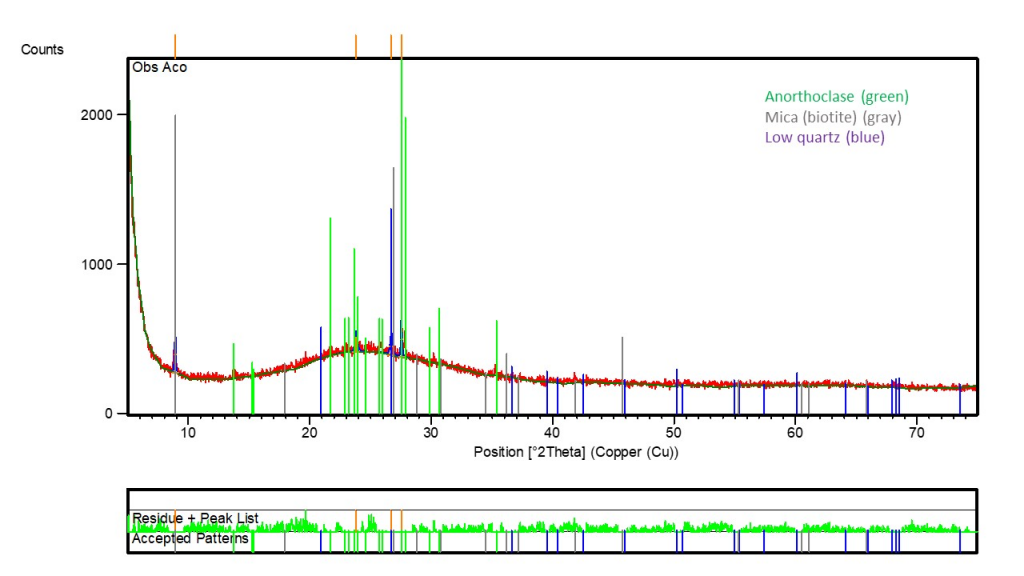
Figure 5 – XRD mineralogy of obsidian sample from Sete Cidades: anorthoclase, mica and low quartz, in amorphous matrix indicated by the expressive wavy back between 15 and 35º 2 theta.
Micromorphological and spot chemical analyzes obtained by SEM/EDS show that the amorphous matrix is dominated in decreasing order by O, Si, Al, Na, K, Fe, Ti and Ca, where Ti and Ca are below 1%. The dominant alkalis are Na and K (from 3 to 5% each), and Fe in the order of 2% (Table 1). This chemical composition corresponds to the domain of anorthoclase and biotite-type mica, which is highlighted by the contents of Fe and Ti, in addition to restricted quartz, which must be immersed as micrometric crystals in the glass matrix, and less frequently as phenocrysts. An example of an anorthoclase phenocryst is illustrated in figure 6. The mineralogical and chemical composition show that the obsidian derived from the consolidation of lava with a rhyolitic composition, as is the case with most of the obsidian (Ellis et al. 2022). Sulfur and chlorine are identified in some pumice texture (Fig. 6). In the next figures 8, 9 and 10, additional matrix chemical results will be presented, and they show similar chemical composition. The chemical composition for studied obsidian from Sete Cidades may be comparable to those presented in table 2, presented by Harmon et al (2023), except for TiO2 and Fe, not indicated, and may classified or correlated to rhyolitic to quartz trachytic lavas. Iron and titanium could be a contribution of mafic (basaltic) events.
Table 1 – SEM/EDS spot chemical analytical data for the general obsidian matrix from Sete Cidade investigated sample.
| Element | Weight % (1) | Weight % (2) | Weight % (3) | Weight % (4) | Average | Oxides
average |
| Oxygen | 51,681 | 48,236 | 41,46 | 45,853 | 46,81 | 0,0 |
| Sodium | 3,233 | 5,093 | 4,28 | 1,597 | 3,55 | Na2O: 4,76 |
| Magnesium | — | 0,292 | — | — | ||
| Aluminum | 7,667 | 8,454 | 6,92 | 7,906 | 7,74 | A2O3: 14,63 |
| Silicon | 31,515 | 31,093 | 24,67 | 37,672 | 31,24 | SiO2: 68,85 |
| Chlorine | 0,263 | 0,259 | ||||
| Potassium | 2,985 | 4,032 | 3,24 | 2,869 | 3,28 | K2O: 3,95 |
| Calcium | 0,301 | — | 0,27 | — | ||
| Titanium | 0,332 | 0,353 | 0,24 | 0,824 | 0,44 | TiO2: 0,73 |
| Iron | 2,023 | 2,188 | 1,72 | 3,279 | 2,30 | FeO: 2,57 |
Table 2 – Chemical composition of obsidian from distinct sources after Harmon et al, (2023). Nd: Not detected.
| Localities | SiO2 | TiO2 | Al2O3 | MgO | CaO | Na2O | K2O |
| Little Sand Butte | 73,00 | 0,27 | 13,90 | 0,35 | 1,25 | 4,01 | 4,33 |
| Glass Mountain | 73,10 | 0,28 | 14,10 | 0,38 | 0,38 | 3,94 | 4,35 |
| Long Valley/Mono-Inyo | 77,05 | 0,07 | 12,58 | 0,03 | 0,44 | 3,96 | 4,68 |
| Long Valley/Mono-Inyo | 77,00 | 0,05 | 12,90 | nd | 0,28 | 4,14 | 4,45 |
| Long Valley/Mono-Inyo | 76,90 | 0,05 | 12,70 | nd | 0,32 | 4,48 | 4,49 |
| Mammoth Mountain | 70,37 | 0,33 | 15,73 | 0,26 | 0,77 | 5,67 | 4,78 |
| Glass Creek Flow | 73,98 | 0,15 | 14,07 | 0,11 | 0,83 | 3,97 | 5,28 |
| Deadman Creek | 70,73 | 0,37 | 15,47 | 0,42 | 1,34 | 4,27 | 4,96 |
| Bald Peak | 76,67 | 0,10 | 13,30 | 0,18 | 0,78 | 2,31 | 5,93 |
| Average | 74,31 | 0,19 | 13,86 | <0,38 | 0,71 | 4,08 | 4,81 |
| Average for Sete Cidades | 68,85 | 0,73 | 14,63 | <0,48 | <0,42 | 4,76 | 3,95 |
The most frequent mineral inclusions in the obsidian matrix after SEM/SED analyses are ilmenite and titanomagnetite, which in general contains Mn and Ni (Fig, 7 and 8), probably imprinting the black color for obsidian, which can occur as nano inclusions.
Other recurring mineralogical inclusions are striped, aligned, reticulated, locally misshapen and with greater volume made up of Cu, Zn and Ni; or Fe, Cr and Ni in the alkali-aluminosilicate matrix, the same observed throughout (Fig, 9). It was considered that the former are as a metallic alloy and the latter as magnetite-type oxides, or even as an alloy, which is fully possible in this rocky environment.
These mineral inclusions come in varied sizes and reach nanometric dimensions, responding to the constant presence of Fe values of around 2% in the matrix. These contents in form of iron oxides are certainly responsible for the black color of most obsidian.
Inclusions of iron oxides in obsidians have already been recognized in optical microscopic studies by Zirkel (1867) who identifies them as magnetite and Fe sesquioxide, and some by the morphology designated trichte. In a recent article, Thewalt & Dörfner (2020) studied these inclusions in black and Mahagoni-type obsidians from Glass Buttes (Oregon, USA). They identified many trichte-type inclusions and in straight or curved parallel threads, dominated by magnetite, sometimes admitted as hematite. Aubin et al. (2023) developed detailed studies on microlite of crystal inclusions, within them the Fe trichites coming from the explosive-effusive eruptions from North Mono eruption, California, U.S.A. They have also carried out experimental studies to understand at what eruption stages these microliths form, both silicate minerals and trichites. They would be in the ash sintering phase to form obsidian still inside the eruptive conduit under pressure from dissolved volatiles. Although the trichites were not found, perhaps because optical microscopy analyzes had not yet been carried out, the microlites in general were identified. Therefore, the obsidian investigated here must have had a formation process.
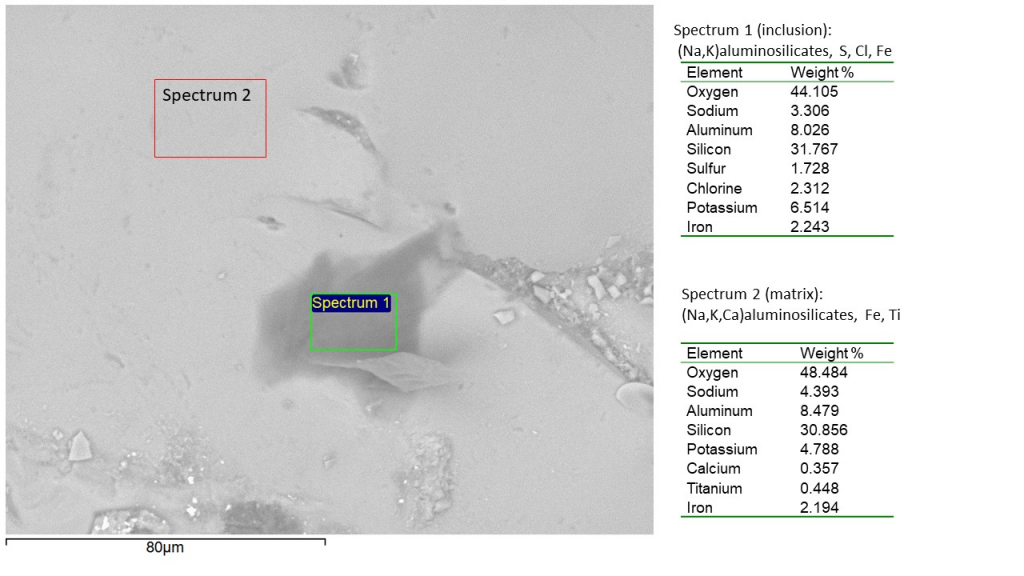
Figure 6 – Comparison between the chemical composition of the matrix (spectrum 2) and an inclusion (spectrum 1), which presents some contents of sulfur and chlorine, The matrix composition doesn`t diverge from other spot analyses. The values of spectrum 2 are similar to those of Tab,1, analysis 1 thru 3.
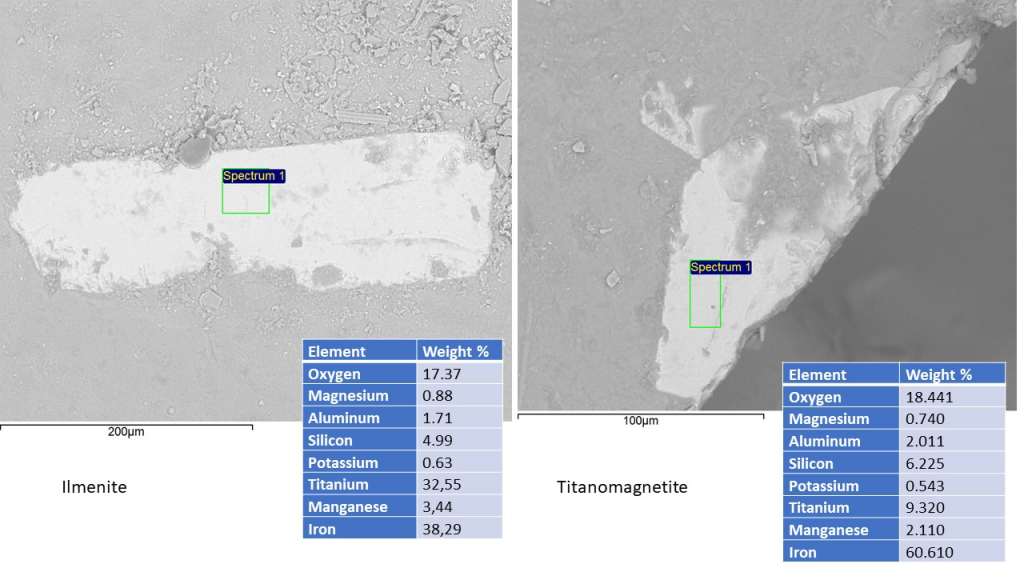
Figure 7 – Inclusions of Fe-Ti oxides in obsidian glass matrix, showing large variation the proportion of Fe and Ti, from ilmenite (Crystal on the left image) to titanomagnetite (image on the right side),
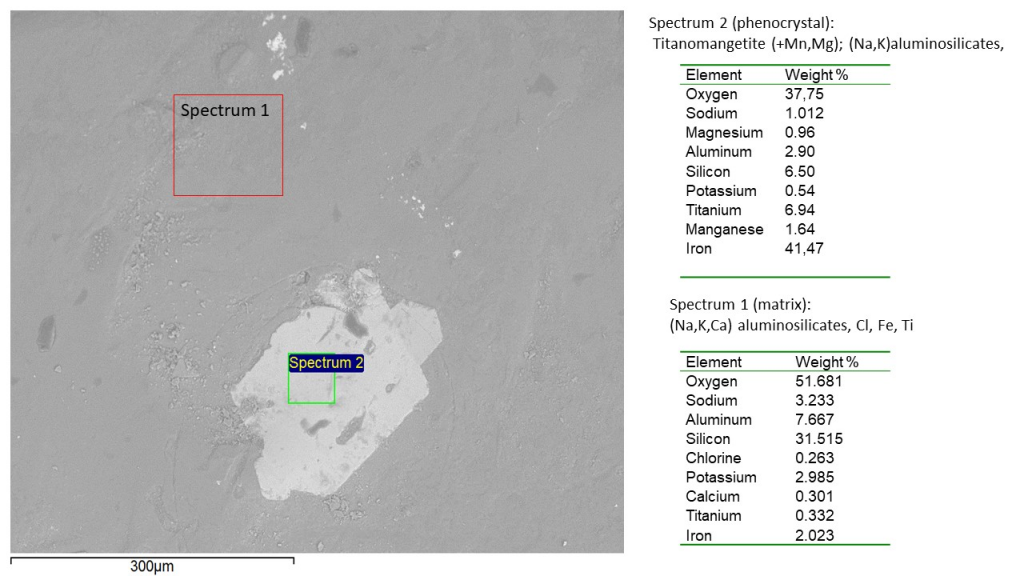
Figure 8 – A possible titanomagnetite crystal inclusion (spectrum 2) in obsidian matrix (spectrum 1) analyses.
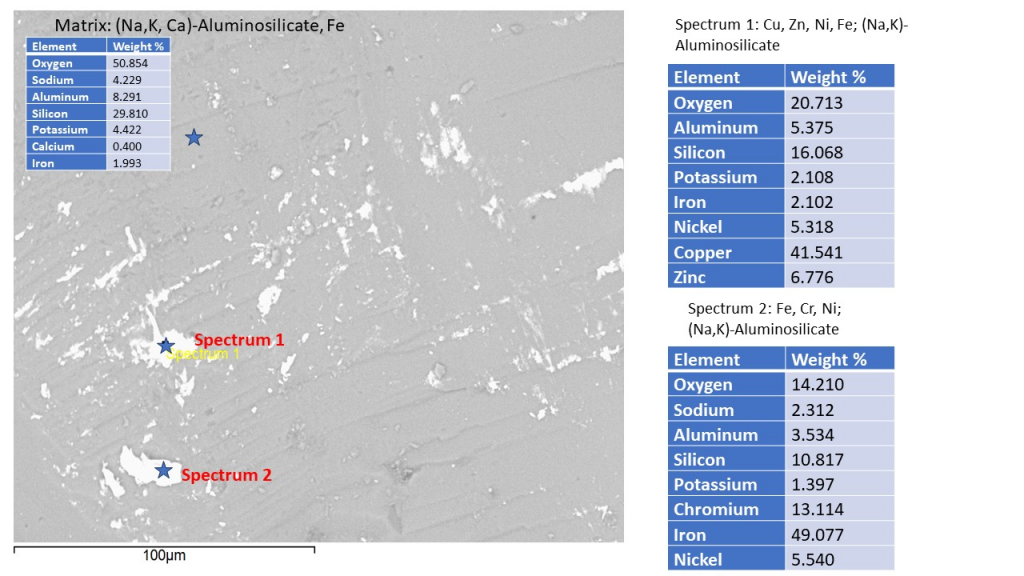
Figure 9 – Mineral inclusions in obsidian matrix showing aligned, stripped and reticulated pattern, made of Cu, Zn and Ni or Fe-Cr-Ni alloys or oxides,
Phenocryst skeletons with a reticulated pattern and absorption or contact edges also appear in the matrix from time to time, in which the chemical composition of the body (Fig, 10 spectrums 4 and 6) is similar to that of the skeleton and the edge (Fig, 10 spectrums 2 and 3), suggesting that it is just a distinct degree of crystallization (Fig, 9), The chemical composition is the same as that of the matrix (Fig, 9 spectrum 5), therefore made of alkali-aluminosilicates with Fe around 1,5 to 3,0 wt.,%, as observed throughout this obsidian, Also a rare gold particle was found (Fig, 10 spectrum 1).
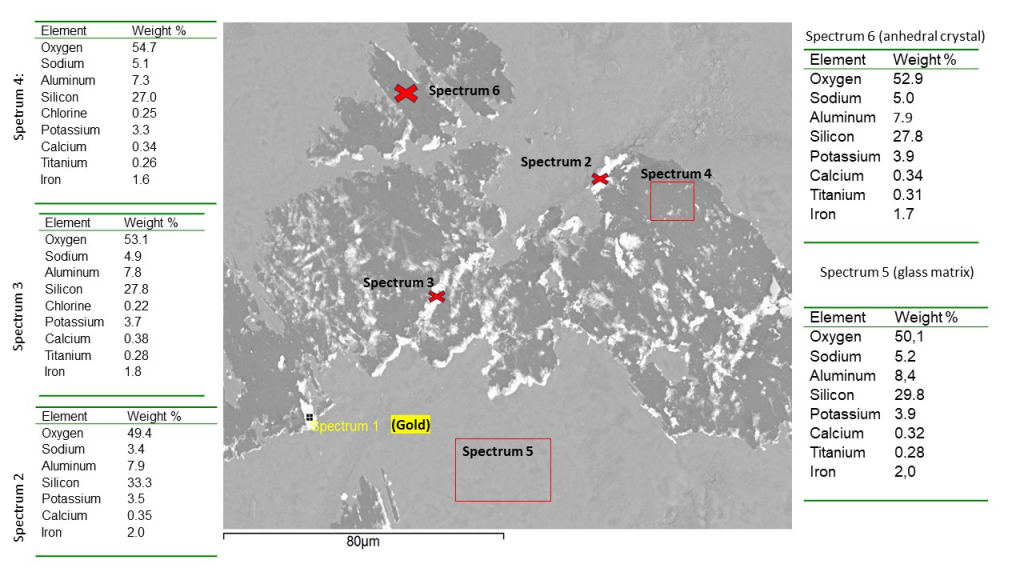
Figure 10 – Phenocryst skeletons with a reticulated pattern and absorption or contact edges in the obsidian matrix. Skeletons and matrix show the same chemical composition; a single gold particle was identified (spectrum 1).
CONCLUSIONS
Although a single sample of obsidian was analyzed from the pyroclastic package from the Sete Cidades volcano, its widespread characteristics are compatible with materials found around the world. The color is black, it is classic, although obsidians with other tones are known and highly appreciated; conchoidal fracture is also typical and ferromagnetic. The sample presents irregular bands of pumice, which undermines the quality of obsidian as a lithic and even gemological artifact. The mineralogical and chemical composition conforms to obsidian formed from rhyolitic to quartz trachytic lavas. The relatively higher levels of FeO and TiO2 are worth highlighting, which appear in the form of magnetite, titanomagnetite and even ilmenite, in micrometric to nanometric inclusions, which account for their black color and slight magnetism. In addition to these micrometric to nanometric inclusions, there are possible alloys of Fe-Cr-Ni and Cu-Zn-Ni and even gold particles, which suggest a slight mafic (basaltic) influence during the acid to alkaline volcanism.
Acknowledgments
The authors thank the support of Lamiga laboratories and the first author financial support from CNPQ (Grants: 442871/2018-0 and 305015/2016-8 and 3049672022-0).
REFERENCES
Aubin, W.L., Gardner, J.E., Watkins, J.M. and Lloyd, M.H. 2023. Construction of obsidian during explosive-effusive eruptions: insights from microlite crystals in obsidian pyroclasts Front. Earth Sci. 11:1183923. doi: 10.3389/feart.2023.1183923
Ellis, B,S, Pimentel, A, Wolff, J,A, Etter, A, Cortes-Calderon, E,A, Harris, C, Mark, D,F, Neukampf, J, Bachmann O, 2022, Geochemistry of the Pepom tephra deposits: The most recent intracaldera volcanism of Sete Cidades volcano, S˜ao Miguel, Azores, Journal of Volcanology and Geothermal Research 432 (2022) 107673, https://doi,org/10,1016/j,jvolgeores,2022,107673
Gaspar, J,L, Guest, J,E, Queiroz, G, Pacheco, J, Pimentel, A, Gomes, A, Marques, R, Felpeto, A, Ferreira, T, Wallenstein, N, 2015a. Eruptive frequency and volcanic hazards zonation in S˜ ao Miguel Island, Azores, In: Gaspar, J,L,, Guest, J,E,, Duncan, A,M,, Barriga, F,J,A,S,, Chester, D,K, (Eds,), Volcanic Geology of Sao ˜ Miguel Island (Azores Archipelago), Geological Society, London, Memoirs, vol, 44, pp, 155–166, https://doi,org/10,1144/M44,12,
Gaspar, J,L, Queiroz, G, Ferreira, T, Medeiros, A,R, Goulart, C,, Medeiros, J, 2015b. Earthquakes and volcanic eruptions in the Azores region: Geodynamic implications from major historical events and instrumental seismicity, In: Gaspar, J,L,, Guest, J,E,, Duncan, A,M,, Barriga, F,J,A,S,, Chester, D,K, (Eds,), Volcanic Geology of Sao ˜ Miguel Island (Azores Archipelago), Geological Society, London, Memoirs, vol, 44, pp, 33–49, https://doi,org/10,1144/M44,4,
Harmon, R, S, Throckmorton, C,S, Haverstock, G, Baron, D, Yohe, R,M, II; Hark, R,R, Knott, J,R, 2023, Connecting Obsidian Artifacts with Their Sources Using Multivariate Statistical Analysis of LIBS Spectral Signatures, Minerals 2023, 13, 1284, https://doi,org/ 10,3390/min13101284.
Zirkel, E. 1867. Mikroskopische Untersuchungen über die glasigen und halbglasigen Gesteine. Z.Deut.Geol.Ges., 19, 737-802.
Walt, U. & Dörfner, G. 2020. Die vielfältigen Formen von Magnetiteinschlüssen in Obsidian – Beobachtungen an Material von den Glass Buttes (oregon, USA). Der Aufschluss, Ausgabe 3, Jahrgang 71: 133-143.

